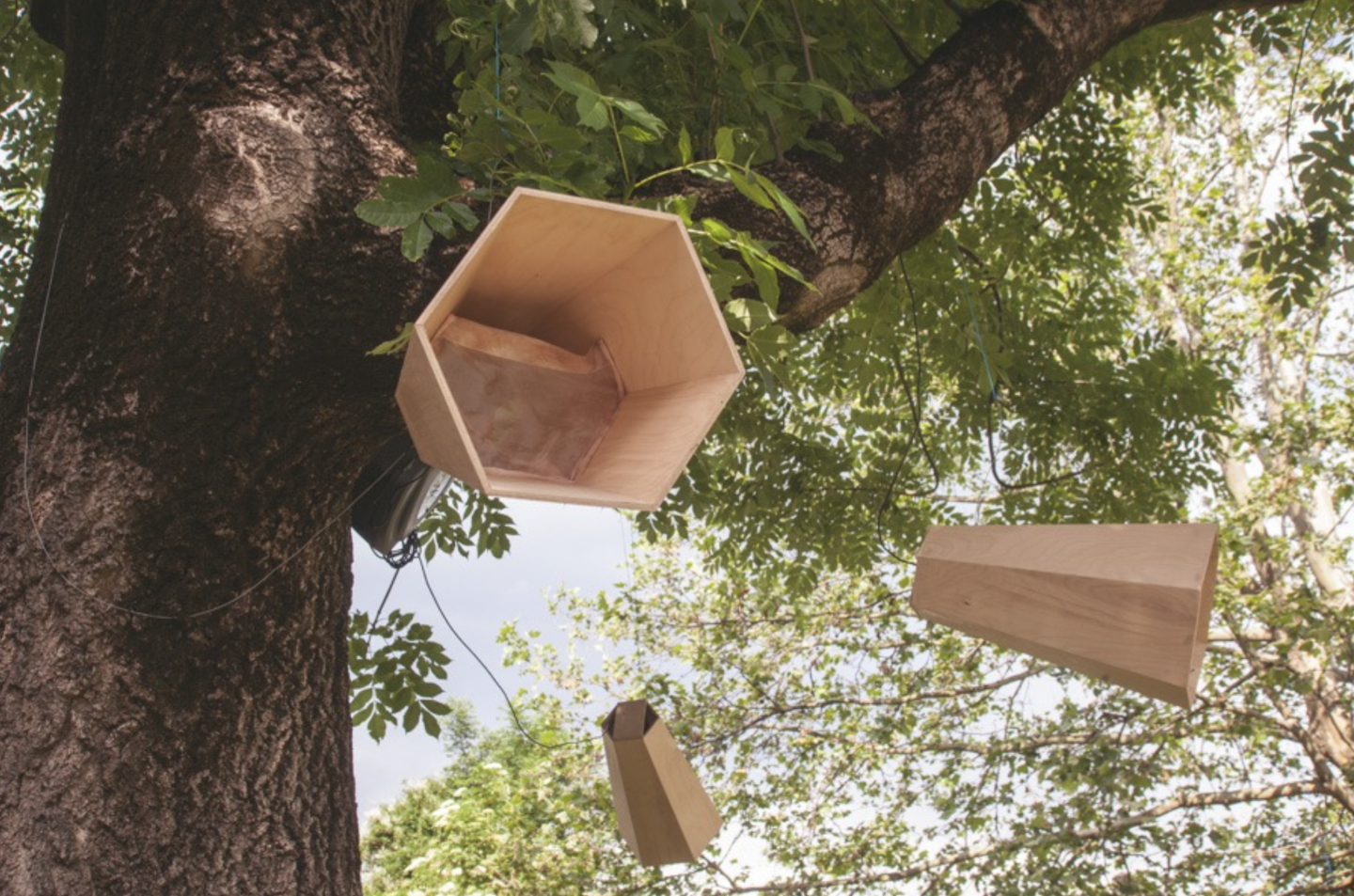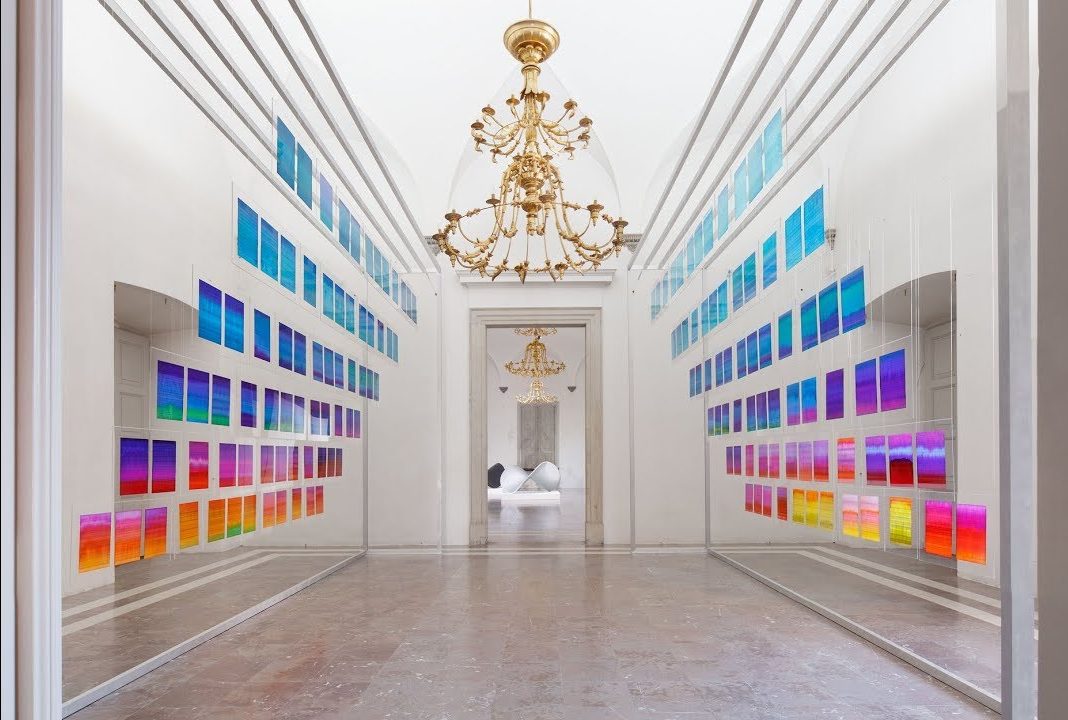Jiří Suchánek is known for his creative manipulation of sound and light, which he uses as information bearers or data generators. He creates very particular installations and objects, often of a highly interactive nature. Movement and space play an important role in his works. All these physical phenomena are connected and run through various technical interfaces to their final form, most often playful “inventions”, but not only that. For an example of Jiří Suchánek’s many layers, let us look to the ATOM TONE project (music as a chemical reaction. Atomic music), within which Suchánek uses spectroscopy to transfer the properties of the electromagnetic waves of each atomic element into a specific sound.
In May and June of this year, Suchánek was one of the two resident sound artists at the Austrian platform for creative work on the boundaries of art and design, openspace. Innsbruck. The residency, Sonic Worlds of Between, was curated by Danijela Oberhof Tonković. Suchánek was institutionally recommended by the Prague Biennale Foundation. The second participant was Mika Motskobili a.k.a. Vo Enz, from Georgia, recommended by the Georgian Centre for Contemporary Art. The residency took place as part of the Magic Carpets 2019 European project. Its aim was to connect institutions and curators, and also, as the name suggests (let us remember the tales of the Thousand and One Nights and the magical mode of transport), to support artists’ travel to various parts of Europe. The selected artists should ideally work with the specific social and political context of the given location, aiming for a synthesis between the local and the international.
MONIKA SVOBODOVÁ
You both have many experiences with placements and residencies. Do you still consider them beneficial? Is “residency tourism” compatible with family life? If the artist is to be successful today, must they be a residency nomad?
JIŘÍ SUCHÁNEK
Only very few residencies are conceived as family-friendly – everything is directed at solitary artists with no commitments… I have a six-year-old daughter who’s going to school this year, so until now, she could always easily visit me. But I have to approach residencies as shorter or interrupted, or I just take my family along and subsidise it. But in reality, there haven’t been that many residencies – there were many more concerts, conferences, exhibitions. All these are short-term affairs; it’s not difficult to arrange these with family life. For me, residencies are one of the few ways to concentrate purely on work, without the constant interruptions of the usual hustle and bustle of city life. Temporarily clearing my head, changing my environment, acquiring new contacts.
DANIJELA OBERHOFER TONKOVIĆ
Nomadism is nothing new in the art world. Nowadays, by using various support and promotion structures, artists are more nomadic than ever before. All of us who are working internationally, between and across the borders, have become a species of nomad. But, in fact, it’s in our DNA. I see that as a blessing.
MS
Did you ever address the ecological impact of frequent travel? Is this a frequent topic among internationally working artists and curators?
JS
Of course it’s a huge topic. Today, it’s tough being an artist without travelling – also because of concerts, presentations, exhibitions, but especially because of self-education. The internet is not enough. I didn’t quite go in that direction, but I know a number of people who are true artistic nomads – they don’t really even have a home, they just move from one place on the planet to another. My base is in Brno, and I (usually) like going back there. Choosing how to get somewhere – and whether to go at all – is up to everyone’s personal responsibility. It’s a dilemma. Being a global artist without air travel is practically unrealistic. Overall, however, I don’t think reducing activities is a solution – rather a gradual, quick and thorough adjustment of the means we use on a daily basis and a reduction of superfluities…
DOT
I actually haven’t done any intensive thinking about this before. But we are already going the right way as much as we can – for instance, by choosing train over air travel if the destination is relatively close. Jiří, for example, did not travel by plane, instead using the railroad and finally his car, whichhe combined with his vacations in the nearby Alps. At the same time, in our Magic Carpets artist pool, we have local artists who simply prefer trains (not traveling by airplanes at all) and residencies that are geographically closer or inclined to accept such a way of thinking.
MS
Danijela, why did you choose Jiří and Mika for the residency?
DOT
First of all, Mika and Jiří really fit into this year’s context and we needed artists for the residency in Innsbruck that work within the territories of sound and media, science, technology and society – feeling equally at home in all these fields. I very much liked their trans-disciplinary approach and the multilayered work they are doing. I also enjoyed our process of communication. Their ways of reflecting their surroundings, how they engage with society, and how both of them have this special, almost subtle, sense for (public) space made both of us – Charly Walter, the director of the openspace, and me – very positively curious.
MS
And why did you choose the subtitle Sonic Worlds of Between?
DOT
The original title I came up with was in German– “Klangwelten des Dazwischen”. “Sonic Worlds of the Between” is the translation that my colleague Marco and I liked the most. In our Magic Carpets journey, openspace strives to find, fill, feel or point at spaces “in between” (diverse spaces – dysfunctional, forgotten, not well used, or not seen, beautiful, ours) and try to vitalize them, to increase their visibility, relevance, or beauty – by, for example, representing possible alternative realities. Detecting (new or existing) potentials and setting them up in a way that tells a story about the city (social, political, historical, etc.). We decided to utilise sound as a primary medium of artistic expression and for discov- ering the potentials of the audibility (of our surroundings) in this year’s project.
MS
Jiří, what works did you create and present in Innsbruck?
JS
I created a brand new interactive installation: OR-bits. It’s an object or instrument which uses a light pendulum moving above photo-sensors to play back (in a strange manner) field recordings from Innsbruck which we made during a workshop. Whenever the light goes by the sensor, it triggers the recording. Compared to what is usually understood by field recording, which, as a genre, is defined and anchored primarily in deep (and slow) listening and the context of acoustic ecology, this approach brought about quite a radical deconstruction of the material and an unexpected wildness that came out of the mosaic of recordings. I spent most of my energy on this project, and to be honest, I barely finished in time. It’s a beta-version and we’re certainly planning an after-life.
The second project was an electroacoustic composition for an 18-channel sound system placed among the trees in front of the Haus der Musik (incidentally, the building was nominated for the Mies van der Rohe Award). This was an absolutely wonderful occasion to create a sonic space in such an exclusive environment. Three old trees – pine, oak and beech – in front of the glass-ceramic facade which mirrored the snowy peaks and old stone sculptures. The entire system was installed by the Klangbaume group, and I had three days for my sonic hallucinations during the Heart of Noise Festival.
And as a third piece, I brought an older installation, Pulse33 (synchronised lights and sounds generated in Max/ MSP), which I also presented as part of the Heart of Noise Festival – it ran continuously in the Haus der Musik foyer.
MS
Do you believe that the synthesis between local and international mentioned above took place?
JS
It happens automatically, at least at the level of relationships and various forms of collaboration. As for the resultant work, I originally did not intend to weave this into it, because to comment – as a “foreigner” – on the context and situation in a city I barely know seemed imprecise. In a new environment, you have the ability to see the situation in an unburdened way, out of context, and you can notice many things the locals miss, but you also struggle to fully understand the local developments. Innsbruck seemed too perfect to me – a living postcard. So I started gravitating towards the dark side of the city and I tried to get this onto the recordings. And – somewhat unexpectedly – personal testimonies from people in Innsbruck also made it in, with selected words and sentences creating new meanings.
DOT
Definitely yes, in so many ways. One of the most important purposes of openspace within the Magic Carpets project is to create a network and merge the local and the international in multiple ways: artists, cultural organizations, institutions, knowledge, and audiences. So, in this year’s project – international artists were organically and very intensely connected to the local art scene (through the processes of collaboration, co-creation, co-working, and exchange) – especially with the local artist and scientist Johannes Payer (a.k.a. ludwig technique) and the artisan Christian Schwarzer. They also merged nicely with the local supporting network we offered, consisting of diverse local organisations from the field of culture, media, community, as well as diverse creative centres, technology centres and entrepreneurial ecosystems (PMK, Spiellokal für Alle, Fablab, Heart of Noise, Hackerspace – IT Syndikat, Verschubu, Klangspuren, Werkstätte Wattens etc). Our three local artists, from our Austrian Magic Carpets pool, went on international residencies in 2019, experiencing a similar joy abroad.
MS
Within those few weeks, Jiří was very active as a resident, taking part in the Heart of Noise Festival, presenting installations, teaching workshops… It sounds like an enormous amount of work. Was it a coincidence, or is this the standard in European residencies?
DOT
As residency coordinators and curators, we try to provide the artist with information, topics, context. I try to indicate some importance and relevance and suggest a methodology. Openspace provides the framework, but we see our cooperation with the artist, and the artist’s intervention itself, as an open process which can deliver a variety of outputs. This time we had this opportunity to experience Jiří, and he was almost unstoppable in creating and launching ideas – he developed and implemented three of them. It was probably an intense time for him – but also a very beautiful and natural embrace. He knew what he should and could do.
We created a very good network of partner organisations (such as openspace, Heart of Noise, Hackerspace
– IT-Syndikat, Fablab, Modular Music Academy, Spiellokal für Alle, Werkstätte Wattens, Wiltener Kultursommer, Haus der Musik etc.) which complemented each other perfectly and, as such, represented an extremely fruitful and creative basis for the selected artists and their work on the interface between sound, society, and technology (science). I imagine that this is very fertile ground for creating and implementing artistic ideas.
Monika Svobodová is an editor of artview section, art writer.


